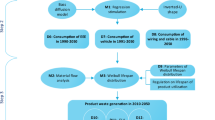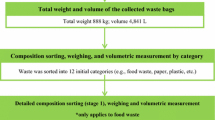Abstract
The consumption inefficiency (CI) index of Bangkok of major product groups (food, plastic, paper, textile, and glass) was annually determined from 1994 to 2018. The CI index ranges from 0 to 1; the higher the index, the lower the consumption efficiency. The results showed that Bangkok had low consumption efficiency with mean CI indices of 0.8 for plastic, 0.7 for glass, and 0.5 for paper product groups. Bangkok had lower mean CI indices of 0.2 for textile and 0.4 for food products. These findings revealed that the high consumption of Bangkokians of plastic, glass, and paper products and inefficient waste sorting (for reuse and/or recycling) before disposal were the co-factors affecting the consumption efficiency of Bangkok. To increase the city’s consumption efficiency, minimization of product consumption and waste for disposal should be considered simultaneously with the improvement of relevant practices and regulations on waste minimization.


Similar content being viewed by others
References
United Nations (2011) The 2011 revision and world urbanization prospects population. Division of the Department of Economic and Social Affairs of the United Nations Secretariat
Hall P (1998) Cities in civilization. Pantheon Books, New York
Newman PWG (1999) Sustainability and cities: extending the metabolism model. Land Use Urban Plan 44:219–226
Kumar S, Bhattacharyya JK, Vaidya AN, Chakrabarti T, Devotta S, Akolkar AB (2009) Assessment of the status of municipal solid waste management in metro cities, state capitals, class I cities, and class II towns in India: an insight. Waste Manag 29:883–895
Browne D, O’Regan B, Moles R (2009) Assessment of total urban metabolism and metabolic inefficiency in an Irish city-region. Waste Manag 29:2765–2771. https://doi.org/10.1016/j.wasman.2009.05.008
Krongkaew M (1996) The changing urban system in a fast-growing city and economy: The case of Bangkok and Thailand. In: Lo F-C, Yrunh, Y-M (eds) Emerging world cities in Pacific Asia. United Nations University Press, Tokyo. https://archive.unu.edu/unupress/unupbooks/uu11ee/uu11ee00.htm#Contents. Accessed 10 Dec 2018
Sukholthaman P, Sharp A (2016) A system dynamics model to evaluate effects of source separation of municipal solid waste management: a case of Bangkok, Thailand. Waste Manag 52:50–61
ADB (2014) Urban metabolism of six Asian cities. Asian Development Bank, Philippines
PCD (2019) Booklet on Thailand state of pollution 2018. Pollution Control Department, Ministry of Natural Resources and Environment, Bangkok
Rosado L, Kalmykova Y, Patrício J (2016) Urban metabolism profiles: An empirical analysis of the material flow characteristics of three metropolitan areas in Sweden. J Clean Prod 126:206–217
WBCSD (2000) Eco-efficiency: creating more value with less impact. World Business Council for Sustainable Development. https://www.ceads.org.ar/downloads/Ecoeficiencia.%20Creating%20more%20value%20with%20less%20impact.pdf. Accessed 10 Sept 2018
Huppes G, Ishikawa M (2005) Eco-efficiency and its terminology. J Ind Ecol 9:43–46
Huang J, Xia J, Yu Y, Zhang N (2018) Composite eco-efficiency indicators for China based on data envelopment analysis. Ecol Ind 85:674–697. https://doi.org/10.1016/j.ecolind.2017.10.040
Chiu C-R, Liou J-L, Wu P-I, Fang C-L (2012) Decomposition of the environmental inefficiency of the meta-frontier with undesirable output. Energy Econ 34:1392–1399. https://doi.org/10.1016/j.eneco.2012.06.003
Zhang J, Zeng W, Shi H (2016) Regional environmental efficiency in China: analysis based on a regional slack-based measure with environmental undesirable outputs. Ecol Ind 71:218–228. https://doi.org/10.1016/j.ecolind.2016.04.040
BMA GIS Center (2016) Shapefiles. https://www.bangkokgis.com/modules.php?m=download_shapefile#map. Accessed 15 Dec 2018
UN-HABITAT (2010) The State of Asian Cities 2010/11. United Nations-ESCAP. https://www.unescap.org/sites/default/files/SoACR.pdf. Accessed 27 Dec 2016
BMA Department of Environment (2019) Solid waste statistics: 2016–2019 (in Thai). https://www.bangkok.go.th/environmentbma/page/sub/7405. Accessed 14 Sept 2009
BMA Department of Environment (2006) Solid waste, hazardous waste, and nightsoil management division: table 4.3. Physical and chemical characteristics of wastes during fiscal year 1994–2005. https://203.155.220.174/pdf/shwasteandnightsoildiv.pdf. Accessed 3 Mar 2019
BMA Department of Environment (2014) Bangkok State of Environment 2012 (Revised edition). https://203.155.220.174/pdf/BangkokStateOfEnvironment2012RevisedEdition.pdf. Accessed 27 Dec 2016
NIDA (2000) The research project on non-registered population in Bangkok Metropolis (in Thai). National Institute of Development Administration, Bangkok
DOPA (2019). Number of population by age (in Thai). https://stat.bora.dopa.go.th/new_stat/webPage/statByAge.php. Accessed 14 Sept 2019
TAT (1998) Internal tourism statistics 1997: central (in Thai). Tourism Authority of Thailand, Bangkok
TAT (2003) Internal tourism statistics 2002: central (in Thai). Tourism Authority of Thailand, Bangkok
TAT (2008) Internal tourism statistics 2007: central (in Thai). Tourism Authority of Thailand, Bangkok
DOT (2019) Tourist statistics (in Thai). Department of Tourism. https://www.mots.go.th/more_news.php?cid=411. Accessed 14 Sept 2019
PCD (2004) The analysis and survey project of solid waste composition in municipalities across Thailand (in Thai). Pollution Control Department, Bangkok
Sirichai C (1991) Glass industry of Thailand (in Thai). Economics 23:10–20
DIP (1999) Situation of glass bottle industry (in Thai). Department of Industrial Promotion. https://library.dip.go.th/multim/edoc/05080.pdf. Accessed 15 Dec 2018
OIE (2019) Industrial statistics (in Thai). Office of Industrial Economics https://www.oie.go.th/academic/statistics. Accessed 14 Sept 2019
TTI (1999) Thai textile statistics 1998. Thailand Textile Institute. https://library.dip.go.th/multim6/ebook/A%20%E0%B8%81%E0%B8%AA%E0%B8%AD14%20%E0%B8%AA1%202541.pdf. Accessed 2 Dec 2018
TTI (2003) Thai textile statistics 2002. Thailand Textile Institute. https://library.dip.go.th/multim1/ebook/A%20%E0%B8%81%E0%B8%AA%E0%B8%AD14%20%E0%B8%AA1%202545.pdf. Accessed 2 Dec 2018
TTI (2008) Thai textile statistics 2007/2008. Thailand Textile Institute. Available at https://library.dip.go.th/multim6/ebook/2552/A%20%E0%B8%81%E0%B8%AA%E0%B8%AD14%20%E0%B8%AA1%202550-2551.pdf. Accessed 2 Dec 2018
TTI (2012) Thai textile statistics 2011/2012. Thailand Textile Institute. https://library.dip.go.th/multim6/ebook/2556/A%20%E0%B8%81%E0%B8%AA%E0%B8%AD14%20%E0%B8%AA1%202554-2555.pdf. Accessed 2 Dec 2018
Thai Center for Development Foundation (2013) Do you know how much paper we use each year? (in Thai). https://www.thaihealth.or.th/Content/20091-รู้หรือไม่%20เราใช้กระดาษปีละเท่าไร.html. Accessed 14 Sept 2019
PIT (2015) Thailand plastics waste: current situation, policy, and idea model for solution. Plastics Institute of Thailand. https://www.mpma.org.my/Documents/Plastics%20Waste%20-%20Current%20Situation,%20Policy%20and%20Idea%20Model%20for%20Solution_Kongsak%20Dokbua.pdf. Accessed 2 Dec 2018
United Nations (2008) International standard industrial classification of all economic activities (ISIC), Rev. 4. New York: United Nations, pp 1–306
Department of Health (2006) The 5th food and nutrition survey report of Thailand in 2003 (in Thai). Ministry of Public Health, Bangkok
Farrant L, Olsen SI, Wangel A (2010) Environmental benefits from reusing clothes. Int J Life Cycle Assess 15:726–736
Sukholthaman P (2012) Bangkok recycling program: an empirical study of an incentive-based recycling program. ScholarlyCommons. https://repository.upenn.edu/cgi/viewcontent.cgi?article=1064&context=mes_capstones. Accessed 10 Dec 2018
Wichai-utcha N, Chavalparit O (2019) 3Rs Policy and plastic waste management in Thailand. J Mater Cycles Waste Manag 21:10–22. https://doi.org/10.1007/s10163-018-0781-y
BMA Department of Environment (2012) Prototype of waste and domestic wastewater management by communities (in Thai). https://203.155.220.174/pdf/BKKcommunityMSW.pdf. Accessed 31 Dec 2018
Chakraborty LB, Sahakian M, Rani U, Shenoy M, Erkman S (2016) Urban food consumption in metro manila: interdisciplinary approaches towards apprehending practices, patterns, and impacts. J Ind Ecol 20:559–570
TEI (2015) Livable city decoding (in Thai). Thailand Environment Institute Foundation, Bangkok
BMA (2007) Action Plan on Global Warming Mitigation 2007–2012. Bangkok Metropolitan Administration, Bangkok
PIT (2013) Thailand's current situation of the recycling industry (in Thai). Plast Foresight 09–02:17–20
Acknowledgements
I thank Dolina Millar for proofreading the manuscript and Thai organizations (Bangkok Metropolitan Administration, Department of Provincial Administration, Office of Industrial Economics, Plastics Institute of Thailand, and Thailand Textile Institute) for providing the relevant data. This work was supported by the Korea Foundation for Advanced Studies’ Asia Research Center of Chulalongkorn University (Contract No. 001/2558).
Author information
Authors and Affiliations
Corresponding author
Ethics declarations
Conflict of interest
No competing interest was reported by the author.
Additional information
Publisher's Note
Springer Nature remains neutral with regard to jurisdictional claims in published maps and institutional affiliations.
Electronic supplementary material
Below is the link to the electronic supplementary material.
Rights and permissions
About this article
Cite this article
Singkran, N. Assessment of urban product consumption and relevant waste management. J Mater Cycles Waste Manag 22, 1019–1026 (2020). https://doi.org/10.1007/s10163-020-00992-w
Received:
Accepted:
Published:
Issue Date:
DOI: https://doi.org/10.1007/s10163-020-00992-w




